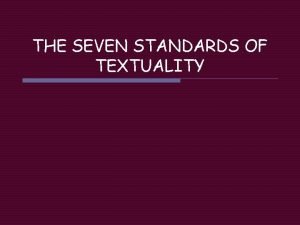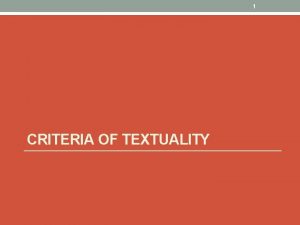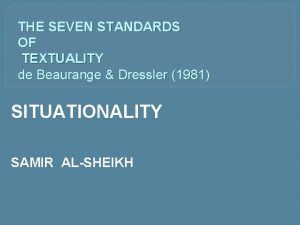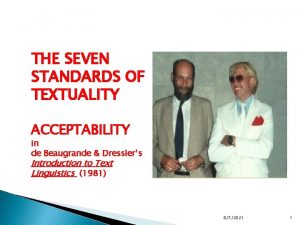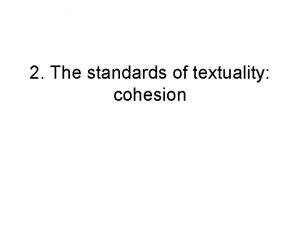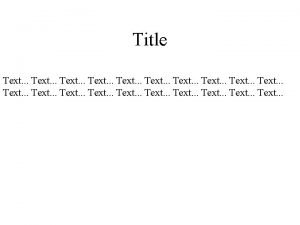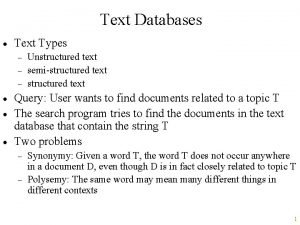THE SEVEN STANDARDS OF TEXTUALITY Definition of text













































- Slides: 45

THE SEVEN STANDARDS OF TEXTUALITY

Definition of text o “A text will be defined as a communicative occurrence which meets seven standards of textuality. ”. .

Cohesion o The first standard will be called cohesion and concerns the way in which the components of the surface text, i. e. the actual words we hear or see, are mutually connected within a sequence. The surface components depend upon each other according to grammatical forms and conventions, such that cohesion rests upon grammatical dependencies. .

o Cohesion is divided into two types as follows: 1. Recurrence 2. Junction

o Recurrence is a direct repetition of elements, since the original occurrence merely happens again (de Beaugrande & Dressler, 1981: 54). Recurrence can be classified as o follows:

Recurrence is a repetition of forms or patterns. For example: o Harry: “You let the troll in? ” o Quarrel: “Certainly. I have special gift with trolls you must have seen what I did to the one in the chamber back there? Unfortunately, while everyone else was running around looking for it, Snape who already suspected me, went straight to the third floor to head me off and not only did my troll fail to beat you to death, that three headed dog didn’t even manage to bite Snape’s leg off properly. ” (Rowling, 1997: 210) The above text shows the repetition or recurrence of the word troll without changing the form, which is recurrence.

Partial recurrence is the use of the same basic word but changing it to a different word class such as to shift the word from adjective to adverb by adding –ly. For example: Christina has a beautiful voice, so she can sing any songs beautifully.

Parallelism is the reusing of a surface format to present new components. For example: The steel pipe crosses windswept plains and endless miles of delicate tundra that tops the frozen ground. It weaves through crooked canyons, climbs sheer mountains, plunges over rocky crags, makes its way through thick forests, and passes over or under hundreds of rivers and streams. (TOEFL Handbook, 2002: 271) The italic verbs above are in the same form, in the present simple tense in agreement with the subject it.

Paraphrase is the recurrence of a subject matter with a change of expression. For example: Original: The Hudson River has a couple of interesting physical features that attract the Europeans to settle. Paraphrase: The Hudson River has two interesting physical features that make it very attractive for settlement by the Europeans. (TOEFL Handbook, 2002: 298)

Pro- form is the repetition of a noun of the same content by a pronoun instead of repeating the same thing. For example: Albus Dumbledore had got to his feet. He was beaming at the students, his arms opened wide, as if nothing could have pleased him more than to see them all there. (Rowling, 1997: 91) The above example shows another way to repeat the same thing by using a pronoun. The name of Albus Dumbledore in the first sentence is repeated by using thepronoun he in the second one.

Ellipsis is omission of a structure and its content. For example: The milk couldn’t be used. All was sour. (Halliday, 1976: 155) The word all in the second sentence refers to all milk in the first sentence, but the word milk is omitted.

Junction is another cohesive device that shows the relationship of components in a sentence. This cohesive device is categorized into four as follows:

Conjunctions are the lexical items that can be used to link things, which are of the same status, such as and, also, besides, furthermore etc. For example: Jill , John and Sim made their way into the tunnel in front of them. (Adirex, 1995: 253)

Disjunctions are the lexical items that are used to link things, which are of alternative status, such as or, either/or etc. For example: Benjamin is going to buy either a digital camera or an MP 3 player with this money.

Contrajunctions are lexical items that are used to link discrepant elements, such as but, yet, however, nevertheless etc. For example: Today there are no silver coins made for general circulation. However, a certain number of special part silver coins are still minted for sale to collectors. These sell at much higher prices than the face – value of the coins. (TOEFL Handbook, 2002: 220)

Subordinations are lexical items that are used to link contents which are dependent on one another, such as because, since, as, thus, while, hence, therefore etc. For example: Because meteorites were formed during the early life of our solar system, they offer valuable information about the history of the earth. (TOEFL Handbook, 2002: 221)

Coherence De Beaugrande and Dressler (1981) explain that coherence refers to a set of conceptual relations under the surface text, which is similar to cohesion in the way stretches of language link each other. Cohesion refers to the surface of the text, while coherence refers to semantics or meaning of the text.

Sriduandao (2003) explains that coherence is like the spirit of a text, and a text can be coherent without cohesive devices. For example: Teacher: Could you tell me a little bit about your neighbor? Student: The Roberts have three children. Julie is the oldest daughter. Joey is a Wednesday child. Jinny is the youngest member of the family. Teacher: Anything else? Student: Their servant is very interfering. The above example shows a conversation between a teacher and a student. This conversation is short of cohesive devices to link the text together, but the receiver can interpret the text easily because the idea of each sentence supports one another well, which is the concept of coherence.

o coherence concerns the ways in which the components of the textual world, i. e. the configuration of concepts and relations which underlie the surface text are mutually accessible and relevant. . Cohesion and coherence are text-centred notions, designating operations directed at the text materials.

Cohesion and coherence o Cohesion and coherence are text-centred notions. o The other standards of textuality are user-centred notions.

Intentionality According to de Beaugrande and Dressler (1981), intentionality seems to be a goal on the author’s mind. The author hopes the target audience will be satisfied with the text. intentionality refers to what a text producer plans to do and what he/ she hopes the target text receiver will accept. De Beaugrande and Dressler (1981) divide the intentionality into two categories: the text producer’s attitudes and a set of goals which are strongly confirmed by the text producer. Each text is written to express the text producer’s intention to the target text receiver.

Acceptability This standard concerns the text receiver’s attitude to evaluate whether the text is acceptable or unacceptable based on the other six attributes of textuality. Each text element must relate to each other and go together well.

It may be said that acceptability concerns the text receiver’s attitude that the set of occurrences should constitute a cohesive and coherent text having some use or relevance for the receiver, e. g. to acquire knowledge or provide co-operation in a plan. .

Example In translating any text, a translator must transfer the message, the attitude and the intention of the author of the original text to the target text so that there will be a clear understanding between the text producer and the receiver. Therefore, the translated text should maintain the same message of the original text. If the translated text is misrepresented or is short of any of the standards of de Beaugrande and Dressler’s (1981) textuality, that translated text is considered unacceptable.

Intentionality and acceptability o Intentionality and acceptability rely on Grice’s cooperative principle: "Make your contribution such as it is required, at the stage at which it occurs, by the accepted purpose or direction of the talk exchange in which you are engaged. "

Grice’s conversational maxims n Maxims of quantity n n Make your contribution as informative as required. Do not make your contribution more informative than is required. n Maxims of quality n n Do not say what your believe to be false. Do not say that for which you lack adequate evidence. n Maxim of relation n Be relevant. n Maxims of manner n n Avoid obscurity of expression. Avoid ambiguity. Be brief. Be orderly.

Maxim of quantity A: Where is the post office? B: Down the road, about 50 metres past the second left. vs. B: Not far.

Maxim of quality A: Should I buy my son this new sports car? B: I don't know if that's such a good idea. His record isn't so great. Vs B: Oh, absolutely. He's only totaled two cars since he got his license last year. He certainly is a careful driver.

Maxim of relevance A: How are you doing in school? B: Not too well, actually. I'm failing two of my classes. vs. B: What fine weather we're having lately!

Maxim of manner A: What did you think of that movie? B: I liked the creative storyline. The ending was really a surprise! vs. B: It was interestingly done sir

Informativity o The fifth standard of textuality is called informativity and concerns the extent to which the occurrences of the presented text are expected vs. unexpected or known vs. unknown/certain.

Informativity refers to the author’s intention to provide information through the text. This standard concerns the extent to which the occurrences of the presented text are expected/unexpected or known/unknown (de Beaugrande & Dressler, 1981: 9). Infomativity is classified into three levels as follows:

In short, informativity influences the comprehension of the text receivers because it relates the information in the text. Moreover, the extent of the information depends on the author’s intention as well as the knowledge and the experience of the target text receiver.

First – order informativity This level focuses on only important content words to make the text informativity. Therefore, the function words such as articles, prepositions, conjunctions etc. are generally omitted. This type of informativity can be found in such text types as telegrams, road signs, warning signs, and advertisements.

Second – order informativity The second – order informativity is another type of information which occurs as an unexpected alternative but a possible one. The attention is reserved for higher-order occurrences (de Beaugrande & Dressler, 1981: 143). For example: Koala and Panda are ______. From the sentence above, some alternatives which are related to Koala and Panda such as animals, bears or mammals occur in mentality. Therefore, this sentence can be completed with any of those.

Third – order informativity The information in the third – order informativity occurs when the text producer accounts for unexpected or unknown alternatives to the target receiver by using general words, loan words with modification to make clearer explanations. Besides, this third -level informativity can be used to upgrade the degree of information. For example: Lemon grass is a grass. The above example cannot give any new idea to the receiver because the explanation has low informativity. This text can be upgraded by giving more sensible information as follows: Lemon grass is a type of grass with lemon flavor that grows in hot countries and is used especially in Asian cooking. (Oxford Dictionary, 2000: 767)

Situationality The situationality is the sixth standard of textuality, which makes a text relevant to the situation of occurrence (de Beaugrande & Dressler, 1981: 9). Generally, people indifferent situations can get different meanings of the same text because of their different experiences. Situationality can help the target audience understand the message of the text easily. Therefore, the producer must create a text according to the circumstance or condition in a particular place and at a particular time. For example, a man raises a T-shirt and says “XL, ” and then a woman gives him an XL one. This example shows that the woman in this situation understands the short utterance “XL” of the man by giving him the XL T-shirt, understanding that he wants to ask for a shirt of this size. They understand the same thing because they are in the same situation.

o The sixth standard of textuality can be designated situationality and concerns the factors which make a text relevant to a situation of occurrence. .

Situationality - contnd connected with coherence and acceptability, e. g. n SLOW CHILDREN AT PLAY n Some elements in text refer to the context of situation (e. g. deictics) and cannot be decoded unless reliance on situationality is made

o The seventh standard is to be called intertextuality and concerns the factors which make the utilization of one text dependent upon knowledge of one or more previously encountered texts.

Intertextuality According to de Beaugrande and Dressler (1981), intertextuality refers to the connection between the target text and the background knowledge of the audience of a text that is inserted into it. This knowledge can be applied by the process called “mediation. ” This standard links the previous knowledge in the target audience’s memory with the inserted one. If the audience has some background, which is familiar to the inserted text, he/she can get the idea about that text.

Intertextuality n e. g. “A tale of two cards” n Headline for an article in the Daily Mail describing the Xmas cards sent by Blair and Howard – reference to Dickens’s novel A Tale of Two Cities o R. de Beaugrande, W. Dressler, An Introduction to Text Linguistics, London, Longman, 1981 (48 ff)


Conclusion In short, the seven standards of textuality proposed by de Beaugrande and Dressler (1981) are appropriate for analyzing any text types including a translated text by emphasizing cohesion, coherence, intentionality, acceptability, informativity, situationality and intertextuality. These seven standards overlap with each other. If the text does not meet any of the said standards, the text may be considered unacceptable.

o o o Bibliographical references: Werlich E. (1979), A Text Grammar of English, Heidelberg, Quelle & Meyer: 17 -26. De Beaugrande R. A. , Dressler W. U. (1981), An Introduction to Text Linguistics, London & New York, Longman: 1 -13 (una sintesi disponibile all’indirizzo: http: //www. beaugrande. bizland. com/introduction_to_text_linguistics. ht m). Van Dijk T. A. (1977), Text and Context. Explorations in the Semantics and Pragmatics of Discourse, London & New York, Longman: 1 -15; 93 -129. Halliday M. A. K. , Hasan R. (1976), Cohesion in English, London & New York, Longman: 1 -30. (M. A. K. Halliday , R. Hasan, Cohesion in English, London, Longman, 1976; M. A. K. Halliday, An Introduction to Functional Grammar, Second Edition, London, Edward Arnold, 1994)
 Beaugrande and dressler standards of textuality
Beaugrande and dressler standards of textuality 7 standard of textuality
7 standard of textuality What is an example of a text-to-media connection?
What is an example of a text-to-media connection? 7 heavenly virtues and deadly sins
7 heavenly virtues and deadly sins Hard customer defined standards
Hard customer defined standards Bram moolenaar
Bram moolenaar Hát kết hợp bộ gõ cơ thể
Hát kết hợp bộ gõ cơ thể Lp html
Lp html Bổ thể
Bổ thể Tỉ lệ cơ thể trẻ em
Tỉ lệ cơ thể trẻ em Voi kéo gỗ như thế nào
Voi kéo gỗ như thế nào Tư thế worm breton là gì
Tư thế worm breton là gì Alleluia hat len nguoi oi
Alleluia hat len nguoi oi Môn thể thao bắt đầu bằng từ đua
Môn thể thao bắt đầu bằng từ đua Thế nào là hệ số cao nhất
Thế nào là hệ số cao nhất Các châu lục và đại dương trên thế giới
Các châu lục và đại dương trên thế giới Công thức tính thế năng
Công thức tính thế năng Trời xanh đây là của chúng ta thể thơ
Trời xanh đây là của chúng ta thể thơ Mật thư anh em như thể tay chân
Mật thư anh em như thể tay chân Phép trừ bù
Phép trừ bù Phản ứng thế ankan
Phản ứng thế ankan Các châu lục và đại dương trên thế giới
Các châu lục và đại dương trên thế giới Thơ thất ngôn tứ tuyệt đường luật
Thơ thất ngôn tứ tuyệt đường luật Quá trình desamine hóa có thể tạo ra
Quá trình desamine hóa có thể tạo ra Một số thể thơ truyền thống
Một số thể thơ truyền thống Cái miệng nó xinh thế
Cái miệng nó xinh thế Vẽ hình chiếu vuông góc của vật thể sau
Vẽ hình chiếu vuông góc của vật thể sau Thế nào là sự mỏi cơ
Thế nào là sự mỏi cơ đặc điểm cơ thể của người tối cổ
đặc điểm cơ thể của người tối cổ V cc
V cc Vẽ hình chiếu đứng bằng cạnh của vật thể
Vẽ hình chiếu đứng bằng cạnh của vật thể Phối cảnh
Phối cảnh Thẻ vin
Thẻ vin đại từ thay thế
đại từ thay thế điện thế nghỉ
điện thế nghỉ Tư thế ngồi viết
Tư thế ngồi viết Diễn thế sinh thái là
Diễn thế sinh thái là Dạng đột biến một nhiễm là
Dạng đột biến một nhiễm là Bảng số nguyên tố
Bảng số nguyên tố Tư thế ngồi viết
Tư thế ngồi viết Lời thề hippocrates
Lời thề hippocrates Thiếu nhi thế giới liên hoan
Thiếu nhi thế giới liên hoan ưu thế lai là gì
ưu thế lai là gì Khi nào hổ con có thể sống độc lập
Khi nào hổ con có thể sống độc lập Sự nuôi và dạy con của hổ
Sự nuôi và dạy con của hổ Sơ đồ cơ thể người
Sơ đồ cơ thể người
